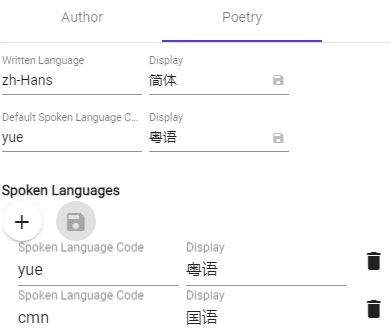Settings for Chinese Poetry: Difference between revisions
Admin>Soulmate mNo edit summary |
Admin>Soulmate |
||
| Line 3: | Line 3: | ||
=== Written Language === | === Written Language === | ||
The Written Language code should be from ISO 639-1, and optionally a code of [https://unicode.org/iso15924/iso15924-codes.html ISO 15924] which is for the representation of names of scripts. | The Written Language code should be from ISO 639-1, and optionally plus a code of [https://unicode.org/iso15924/iso15924-codes.html ISO 15924] which is for the representation of names of scripts. | ||
For example, the language code for Chinese is "zh". If | For example, the language code for Chinese is "zh". If your primary written language is Simplified Chinese and want the app to be able to provide Traditional Chinese representation of your poetry, you should declare the written language as "zh-Hans". Likewise, if you draft in Traditional Chinese, then you should declare the written language as "zh-Hant". | ||
==== Applications of Written Language ==== | ==== Applications of Written Language ==== | ||
The written language | The written language code will be used to render the lang attribute of appropriate HTML elements in the GUI for optimal rendering of fonts. That is, the country code plus the written language sub code like "zh-Hans" or "zh-Hant" will be injected to the container element containing the content. | ||
For | For examples, with the same font "Roboto", different lang attribute may cause the Web browser to render differently. | ||
[[File:Hant.png|center|thumb|zh-Hant]] | |||
[[File:Hans.png|center|thumb|zh-Hans]] | |||
For more details, Please check: | |||
* [https://www.w3.org/International/questions/qa-lang-why Why use the language attribute?] | * [https://www.w3.org/International/questions/qa-lang-why Why use the language attribute?] | ||
| Line 17: | Line 23: | ||
=== Spoken Languages === | === Spoken Languages === | ||
This section is for the convenience of document ryhme of poems if you write poems with ryhme matching multiple spoken languages. | |||
The Spoken Language code should be from [https://iso639-3.sil.org/code_tables/639/data ISO-639-3]. For example, there are 16 [https://iso639-3.sil.org/code/zho declared spoken languages/dialects for Chinese], and you should pick one like: | The Spoken Language code should be from [https://iso639-3.sil.org/code_tables/639/data ISO-639-3]. For example, there are 16 [https://iso639-3.sil.org/code/zho declared spoken languages/dialects for Chinese], and you should pick one like: | ||
| Line 22: | Line 30: | ||
# "cmn" being displayed as "åèª" or "æ®éè¯". | # "cmn" being displayed as "åèª" or "æ®éè¯". | ||
# "nan" being displayed as "é½åè¯" or "å°èª". | # "nan" being displayed as "é½åè¯" or "å°èª". | ||
'''Remarks:''' | |||
Macrolanguage identifiers like "zho" is not used here. And only individual language identifier like "yue" and "cmn" is used. And obviously if you write poems with ryhme matching only one individual language, you don't need to define Spoken language. | |||
Revision as of 21:12, 9 October 2022
In the 20th century, written Chinese diverged into two canonical forms, simplified Chinese and traditional Chinese. And there exist wide varieties of spoken Chinese for the sake of ryhme.
Written Language
The Written Language code should be from ISO 639-1, and optionally plus a code of ISO 15924 which is for the representation of names of scripts.
For example, the language code for Chinese is "zh". If your primary written language is Simplified Chinese and want the app to be able to provide Traditional Chinese representation of your poetry, you should declare the written language as "zh-Hans". Likewise, if you draft in Traditional Chinese, then you should declare the written language as "zh-Hant".
Applications of Written Language
The written language code will be used to render the lang attribute of appropriate HTML elements in the GUI for optimal rendering of fonts. That is, the country code plus the written language sub code like "zh-Hans" or "zh-Hant" will be injected to the container element containing the content.
For examples, with the same font "Roboto", different lang attribute may cause the Web browser to render differently.
For more details, Please check:
Spoken Languages
This section is for the convenience of document ryhme of poems if you write poems with ryhme matching multiple spoken languages.
The Spoken Language code should be from ISO-639-3. For example, there are 16 declared spoken languages/dialects for Chinese, and you should pick one like:
- "yue" being displayed as "粤èª"ï¼â广ä¸è¯â or "广å·è¯".
- "cmn" being displayed as "åèª" or "æ®éè¯".
- "nan" being displayed as "é½åè¯" or "å°èª".
Remarks:
Macrolanguage identifiers like "zho" is not used here. And only individual language identifier like "yue" and "cmn" is used. And obviously if you write poems with ryhme matching only one individual language, you don't need to define Spoken language.
